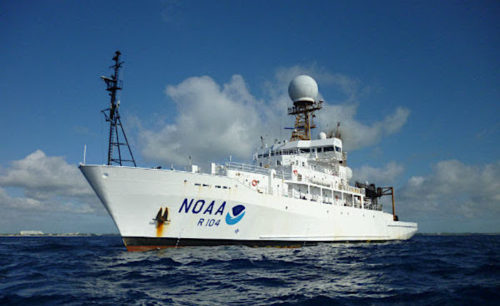NOAA’s largest oceanographic research vessel, NOAA Ship Ronald H. Brown, steamed into its Charleston, South Carolina, home port Tuesday after a 243-day voyage around the world to conduct scientific research and service buoys that inform global weather, climate and ocean forecasting.
The ship sailed nearly 44,289 miles, made port calls in South Africa, the Seychelles, India, Australia and Hawaii, and opened its decks to international partner scientists and school children.
“Working across the global ocean, the ship, her crew and our scientists are helping expand our understanding of the ocean’s profound effects on weather, climate, fisheries and our economy,” said Craig McLean, assistant NOAA administrator for Oceanic and Atmospheric Research.
A highpoint was the arrival of Brown in Goa, India, in June, to take part in a major U.S. -India science colloquium that brought together 20 U.S. scientists and 200 Indian scientists to advance ocean observations used to improve climate, weather and fisheries prediction. The meeting in India came after the Brown’s historic oceanographic cruise through the Indian Ocean and Arabian Sea, a rarely studied region that the United States last surveyed 23 years ago.
During the mission that began on Feb. 23, the crew and scientists aboard the Brown also:
Deployed, serviced and recovered more than 80 buoys that monitor ocean and weather conditions in the tropical ocean, including the weather maker, El Niño, and the Madden-Julian Oscillation, a phenomena that begins in the Indian Ocean and influences U.S. heat waves and flooding.
Made 14 tows using special nets to collect plankton, the tiny marine plants and animals that are the foundation of the ocean food chain
Collected and analyzed more than 10,570 gallons of seawater from surface to bottom to investigate changes in ocean chemistry
The dedication, commitment and collective efforts of NOAA Ship Ronald H. Brown’s officers, crew and scientists have proved invaluable to supporting NOAA and the nation,” said Rear Admiral Michael J. Silah, director of the NOAA Commissioned Officer Corps and NOAA Office of Marine and Aviation Operations. “I commend them for their exemplary service and many accomplishments during this extended deployment.”
The 274-foot ship is a global-class oceanographic and atmospheric research platform operated by NOAA’s Office of Marine and Aviation Operations, which includes civilians and NOAA Corps officers. As many as 60 officers, crew and scientists were on the ship at once.
Related Posts:
Copyright Ships & Ports Ltd. Permission to use quotations from this article is granted subject to appropriate credit given to www.shipsandports.com.ng as the source.
